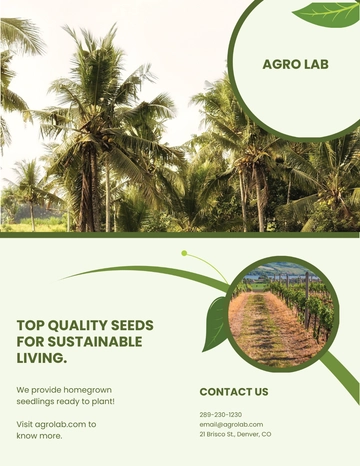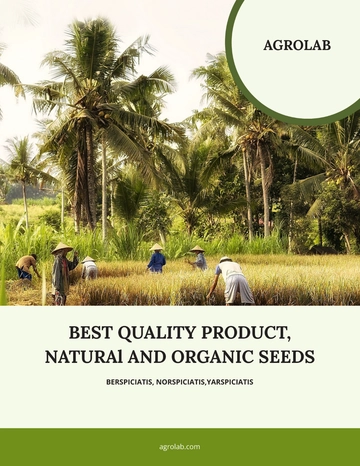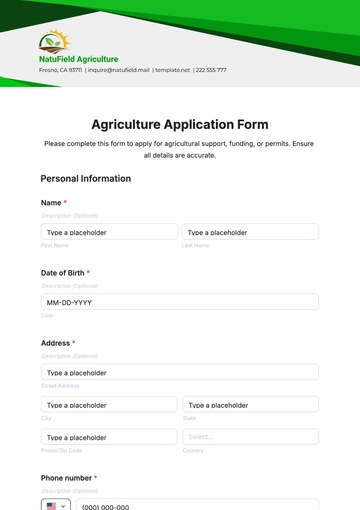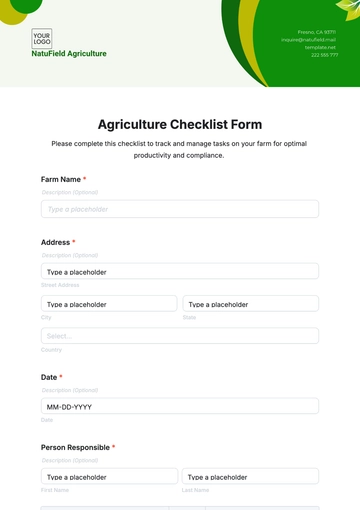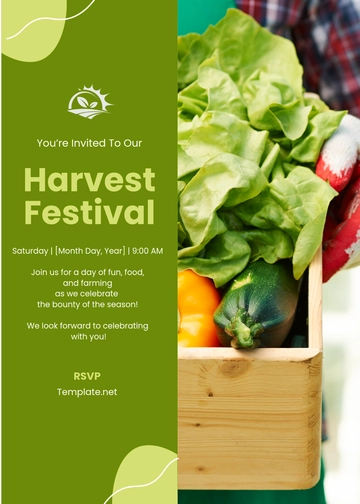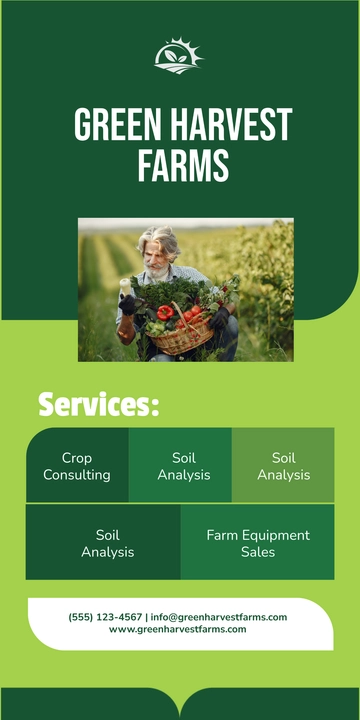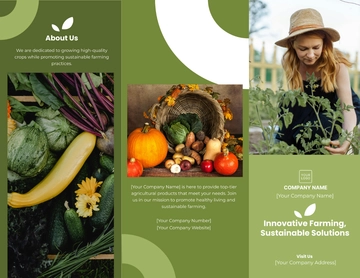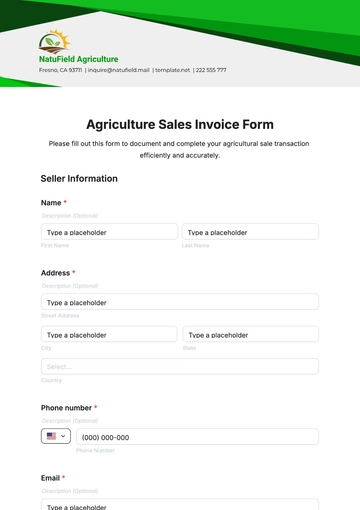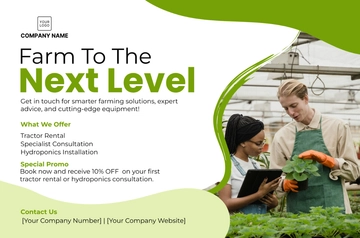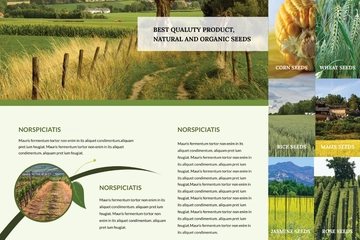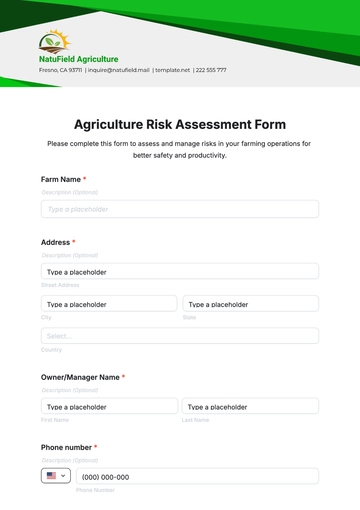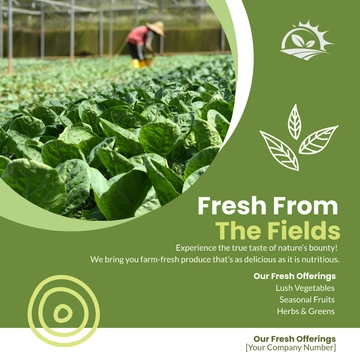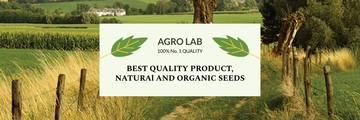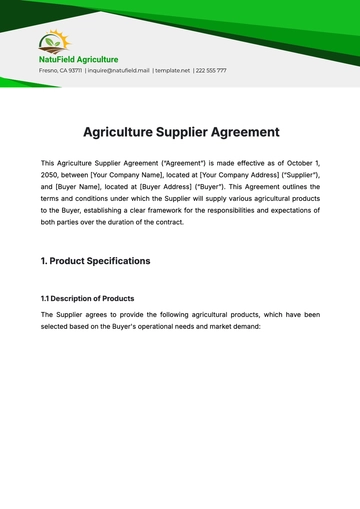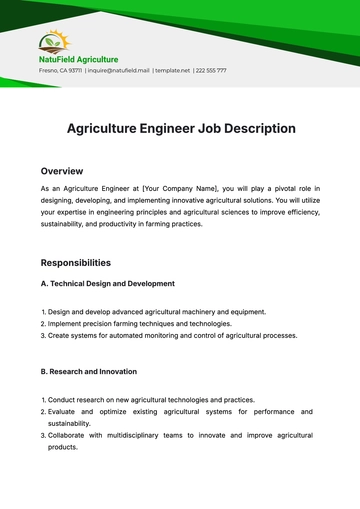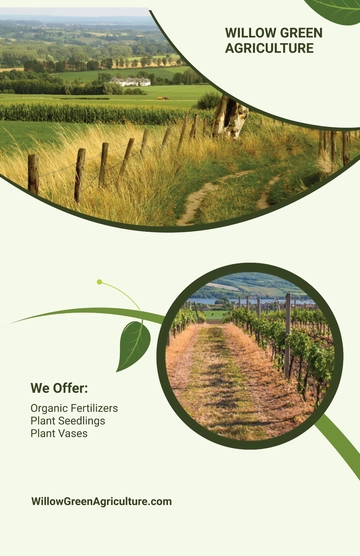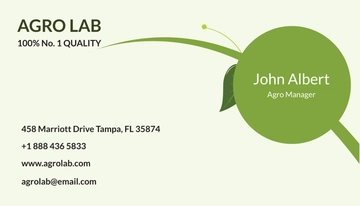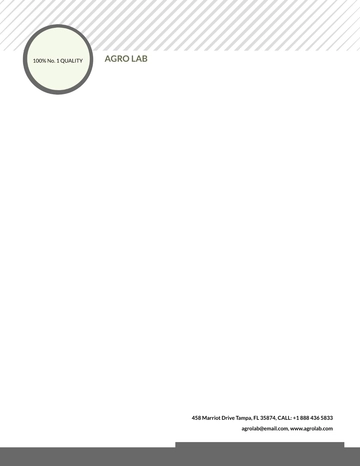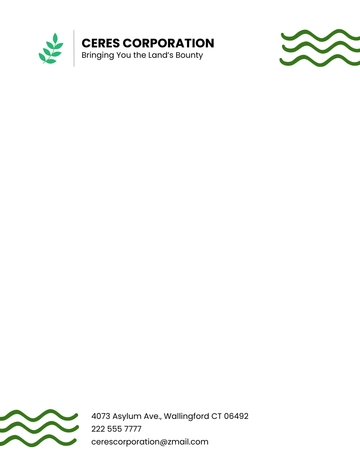Free Agriculture Market Penetration Strategy
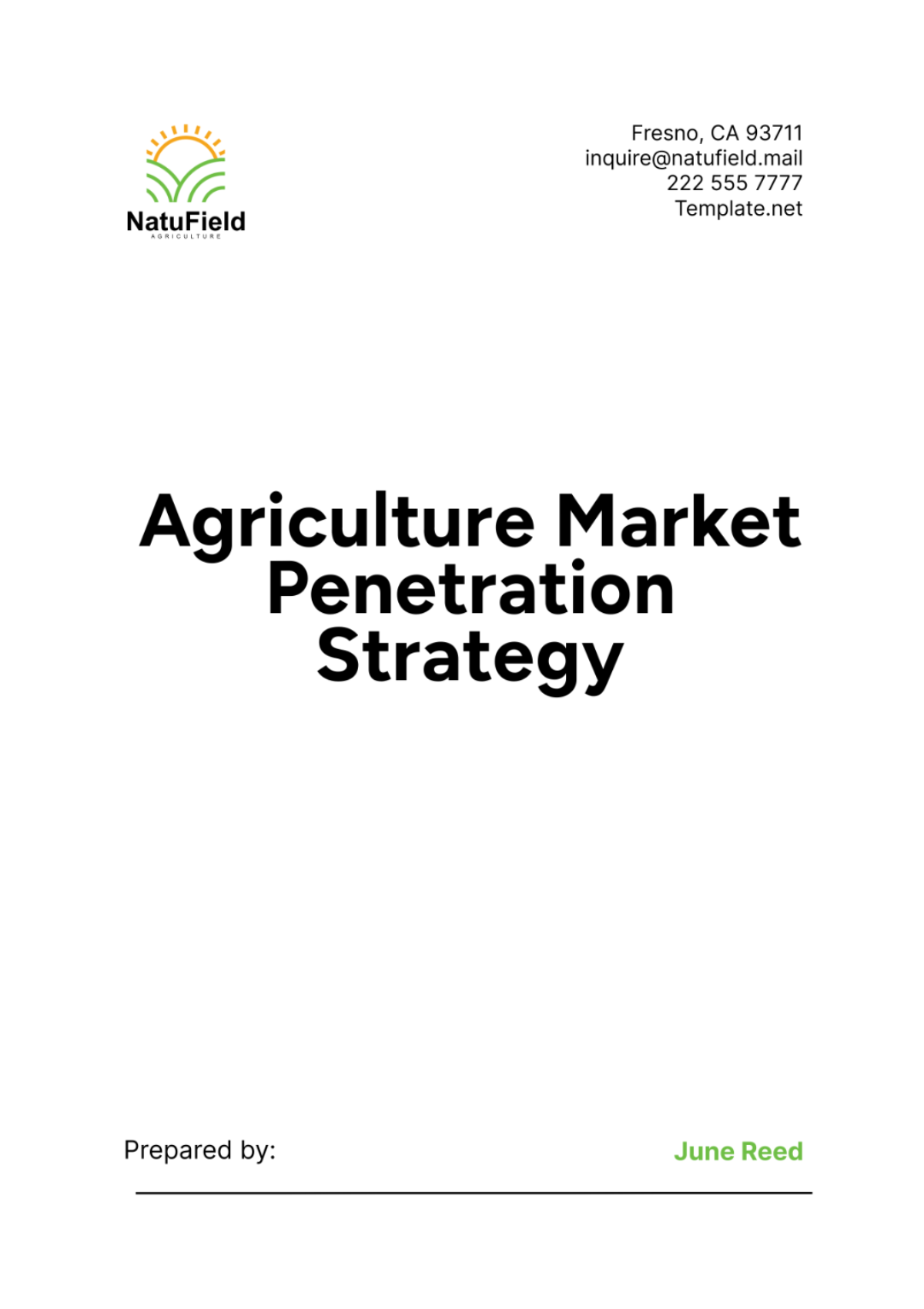
I. Executive Summary
A. Overview
The agriculture industry stands at the forefront of global economic stability, essential for providing sustenance, raw materials, and livelihoods worldwide. [Your Company Name], recognizing the pivotal role of agriculture, aims to leverage technological innovation to enhance productivity, sustainability, and profitability within this dynamic sector. This strategy outlines our proactive approach to penetrate key agricultural markets, positioning [Your Company Name] as a leader in agricultural technology solutions.
B. Objectives
Increase Market Share: Our primary goal is to capture a 15% market share in targeted agricultural regions over the next five years, driven by innovative product offerings and strategic market expansion.
Revenue Growth: By 2050, we aspire to generate $50 million in annual revenue from our comprehensive portfolio of agricultural products and services, underpinned by robust market strategies and operational excellence.
Brand Recognition: Establishing [Your Company Name] as a trusted brand synonymous with cutting-edge agricultural technology and sustainable practices is paramount to our long-term strategy.
C. Key Strategies
Product Innovation: Continuously innovate and develop agricultural technologies that address industry challenges, such as precision farming, crop management systems, and sustainable agri-practices, ensuring our solutions remain at the forefront of industry advancement.
Market Expansion: Strategically expand into new geographic markets with high agricultural potential, leveraging local partnerships and market insights to tailor offerings that meet regional needs and preferences effectively.
Partnerships and Alliances: Forge strategic alliances with key stakeholders including technology providers, research institutions, governmental bodies, and agricultural cooperatives to foster innovation, expand market reach, and enhance operational synergies.
Marketing and Sales: Deploy targeted marketing campaigns that showcase our technological prowess and value propositions, supported by a robust sales infrastructure to drive adoption and market penetration.
II. Market Analysis
A. Industry Overview
The agriculture industry continues to evolve rapidly, spurred by technological advancements, changing consumer preferences, and global sustainability imperatives. As populations grow and urbanization accelerates, the demand for efficient, sustainable agricultural practices intensifies, presenting significant opportunities for innovation and growth.
1. Market Size and Growth
The global agriculture market, valued at $8.5 trillion in 2054, is projected to expand at a compound annual growth rate (CAGR) of 4.2% over the next decade. This growth trajectory underscores the industry's resilience and potential for innovation-driven transformation.
Year | Market Value (Trillions) | Growth Rate (%) |
|---|---|---|
2050 | $7.0 | 3.8 |
2051 | $7.3 | 4.3 |
2052 | $7.6 | 4.1 |
2053 | $8.1 | 4.6 |
2054 | $8.5 | 5.0 |
2. Key Trends
Technological Advancements: The integration of Internet of Things (IoT), artificial intelligence (AI), and big data analytics is revolutionizing farming practices, enhancing productivity, and optimizing resource allocation.
Sustainability Initiatives: Increasingly stringent environmental regulations and consumer preferences are driving the adoption of sustainable agricultural practices, including organic farming, soil health management, and water conservation measures.
Precision Agriculture: Adoption of GPS technology, drones, and sensor-based systems for precision farming is gaining momentum, enabling farmers to monitor crop health, optimize input usage, and maximize yields efficiently.
B. Target Market
1. Geographic Segments
North America: Known for its advanced agricultural infrastructure and high adoption rates of technology-driven farming practices, making it a lucrative market for precision agriculture solutions and sustainable farming technologies.
Europe: With a strong emphasis on sustainability and organic farming, European markets prioritize technologies that promote environmental stewardship and resource efficiency across diverse agricultural landscapes.
Asia-Pacific: Emerging economies in Asia-Pacific, such as India and China, present immense opportunities for growth due to their expanding agricultural sectors and increasing investments in modern farming techniques.
Latin America: Brazil and Argentina lead in agricultural production, particularly in soybeans, corn, and livestock, offering fertile ground for introducing innovative farming technologies and enhancing productivity.
Region | Market Value (Billions) | Growth Rate (%) |
|---|---|---|
North America | $2.5 | 3.5 |
Europe | $2.0 | 4.0 |
Asia-Pacific | $3.0 | 5.5 |
Latin America | $1.0 | 4.8 |
2. Customer Segments
Large-Scale Farms: Operate vast agricultural enterprises requiring sophisticated technologies for efficient management of crops, livestock, and resources.
Small to Medium-Sized Farms: Seek cost-effective solutions that enhance productivity and profitability while adapting to varying climatic and economic conditions.
Agricultural Cooperatives: Collaborative entities that pool resources to leverage economies of scale, benefiting from comprehensive solutions that optimize operations and enhance market competitiveness.
Government and NGOs: Engaged in promoting sustainable agricultural practices and rural development initiatives, representing pivotal stakeholders in driving policy reforms and technological adoption.
III. Competitive Analysis
A. Key Competitors
Competitor A: A market leader in precision agriculture solutions, offering integrated platforms for farm management and yield optimization.
Competitor B: Renowned for its sustainable farming technologies, specializing in soil health management, crop protection, and environmental conservation practices.
Competitor C: Innovator in agricultural machinery and equipment, providing cutting-edge solutions for mechanized farming operations and post-harvest management.
B. SWOT Analysis
1. Strengths
Innovative Products: [Your Company Name] boasts a robust portfolio of agricultural technologies, including AI-driven crop monitoring systems, IoT-enabled irrigation solutions, and predictive analytics for precision farming applications.
Experienced Team: Our multidisciplinary team comprises agronomists, engineers, and data scientists with extensive expertise in agricultural technology development and deployment.
2. Weaknesses
Brand Recognition: Despite our technological prowess, [Your Company Name] faces challenges in brand recognition compared to entrenched competitors with longstanding market presence and established customer bases.
Distribution Network: Enhancing our distribution network to ensure seamless product availability and customer support remains critical to effectively penetrating diverse regional markets.
3. Opportunities
Market Growth: The expanding global agriculture market presents abundant opportunities for [Your Company Name] to introduce innovative solutions that address evolving industry needs and consumer preferences.
Technological Adoption: Increasing acceptance of advanced technologies among farmers and agricultural stakeholders creates a conducive environment for scaling our product offerings and driving market penetration.
4. Threats
Market Competition: Intense competition from well-established players with extensive resources and established market footholds poses a significant challenge to [Your Company Name]'s market expansion and customer acquisition efforts.
Regulatory Changes: Evolving regulatory landscapes and policy shifts related to agriculture, environmental sustainability, and data privacy may impact our operational strategies and market compliance requirements.
IV. Product Strategy
A. Product Development
Innovative Solutions: [Your Company Name] is committed to continuous innovation, focusing on developing next-generation agricultural technologies that empower farmers with actionable insights, enhance operational efficiency, and optimize resource utilization across diverse farming environments.
Customization: We prioritize offering customizable solutions tailored to meet the unique needs and preferences of different customer segments, ensuring scalability and adaptability in addressing specific market challenges and opportunities.
B. Product Launch Plan
Market Research: Rigorous market research and customer feedback mechanisms inform our product development roadmap, guiding strategic decision-making and ensuring alignment with market demand and technological trends.
Pilot Testing: Controlled pilot projects enable us to validate product performance, efficacy, and user experience in real-world agricultural settings, facilitating iterative improvements and adjustments prior to full-scale market deployment.
Marketing Campaign: A comprehensive marketing strategy encompasses targeted digital campaigns, participation in industry trade shows and exhibitions, and partnerships with agricultural influencers and thought leaders to amplify brand visibility and drive customer engagement.
Milestone | Timeline | Budget (Millions) |
|---|---|---|
Market Research | Q1 2050 | $1.0 |
Pilot Testing | Q2 2050 | $2.5 |
Marketing Campaign | Q3 2050 | $5.0 |
V. Market Expansion
A. Geographic Expansion
North America: Strategic entry into key agricultural hubs such as California's Central Valley and the Midwest, leveraging partnerships with local farming communities and technology adoption initiatives.
Europe: Penetrating markets in Germany, France, and the Netherlands, renowned for their progressive agricultural policies, sustainable farming practices, and strong demand for innovative agricultural technologies.
Asia-Pacific: Expanding presence in emerging markets like India and China, characterized by large agricultural landscapes, increasing mechanization trends, and growing investments in smart agriculture solutions.
Latin America: Entering markets in Brazil and Argentina, focusing on enhancing productivity in soybean, corn, and livestock sectors through advanced farming technologies and strategic partnerships with regional agricultural cooperatives.
B. Entry Strategy
Partnerships: Collaborating with local distributors, agricultural cooperatives, and governmental agencies to establish robust supply chains, facilitate market entry, and navigate regulatory frameworks effectively.
Local Presence: Establishing regional offices and technical support centers to provide localized customer service, technical training, and ongoing support, ensuring seamless integration and adoption of [Your Company Name]'s solutions within diverse cultural and operational contexts.
Regulatory Compliance: Prioritizing adherence to regional regulatory requirements and industry standards governing agricultural practices, product safety, and environmental sustainability to build trust, mitigate risks, and foster long-term partnerships.
VI. Marketing and Sales Strategy
A. Marketing
Brand Building: Cultivating a distinctive brand identity centered around innovation, reliability, and sustainability through targeted storytelling, thought leadership content, and engaging digital marketing campaigns across multiple channels.
Digital Marketing: Harnessing the power of digital platforms, search engine optimization (SEO), social media marketing, and content marketing strategies to amplify brand visibility, drive inbound traffic, and nurture leads through targeted educational content and interactive user experiences.
Trade Shows and Events: Participating in premier industry trade shows, agricultural expos, and community events to showcase [Your Company Name]'s product innovations, engage with key stakeholders, and forge meaningful partnerships that support market expansion and customer acquisition efforts.
Marketing Channel | Budget (Millions) | Expected Reach (Millions) |
|---|---|---|
Digital Marketing | $3.0 | 10.0 |
Trade Shows and Events | $2.0 | 2.5 |
Print Media | $1.0 | 1.0 |
B. Sales
Sales Team: Building a dedicated sales force equipped with deep industry knowledge, technical expertise, and consultative selling skills to effectively engage with diverse customer segments, understand their unique challenges, and position [Your Company Name]'s solutions as indispensable tools for driving agricultural productivity and profitability.
Training: Providing comprehensive training programs and continuous professional development opportunities to empower sales teams with in-depth product knowledge, sales techniques, and market insights necessary to navigate complex sales cycles, overcome objections, and deliver exceptional customer experiences.
Sales Channels: Leveraging a hybrid sales approach encompassing direct sales channels, distributor partnerships, and e-commerce platforms to optimize market coverage, expand market reach, and accommodate diverse customer preferences for purchasing agricultural technology solutions.
Sales Channel | Revenue Target (Millions) | Commission (%) |
|---|---|---|
Direct Sales | $25.0 | 5 |
Distributors | $15.0 | 10 |
Online Sales | $10.0 | 3 |
VII. Partnerships and Alliances
A. Strategic Partnerships
Technology Providers: Collaborating with leading technology providers to integrate state-of-the-art sensors, data analytics platforms, and artificial intelligence solutions into [Your Company Name]'s product ecosystem, enhancing functionality, performance, and predictive capabilities for precision agriculture applications.
Research Institutions: Partnering with renowned agricultural research institutions and universities to conduct collaborative research, validate product efficacy, and develop evidence-based solutions that address emerging challenges and opportunities in sustainable farming practices, crop management, and environmental stewardship.
Government Agencies: Engaging with local, national, and international governmental agencies to support policy advocacy efforts, influence regulatory frameworks, and secure funding opportunities for agricultural innovation projects aimed at promoting sustainable development, food security, and rural economic growth.
B. Alliance Benefits
Shared Resources: Pooling expertise, resources, and technological capabilities through strategic alliances to accelerate innovation, scale operations, and deliver value-added solutions that meet evolving customer needs and market demands effectively.
Market Access: Expanding market reach and penetration into new geographic regions, customer segments, and vertical markets by leveraging partner networks, distribution channels, and collaborative go-to-market strategies that enhance brand visibility, credibility, and competitive advantage in the global agricultural technology landscape.
Enhanced Credibility: Establishing credibility, trust, and industry leadership through strategic partnerships with reputable organizations, industry associations, and thought leaders that endorse [Your Company Name]'s commitment to excellence, innovation, and sustainable agricultural practices.
VIII. Financial Projections
A. Revenue Forecast
Year | Revenue (Millions) | Growth Rate (%) |
|---|---|---|
2050 | $10.0 | |
2051 | $20.0 | 100 |
2052 | $30.0 | 50 |
2053 | $40.0 | 33 |
2054 | $50.0 | 25 |
B. Cost Analysis
Cost Category | 2050 (Millions) | 2051 (Millions) | 2052 (Millions) | 2053 (Millions) | 2054 (Millions) |
|---|---|---|---|---|---|
Research and Development | $5.0 | $6.0 | $7.0 | $8.0 | $9.0 |
Marketing | $4.0 | $5.0 | $6.0 | $7.0 | $8.0 |
Sales and Distribution | $3.0 | $4.0 | $5.0 | $6.0 | $7.0 |
Operations | $2.0 | $2.5 | $3.0 | $3.5 | $4.0 |
C. Profit and Loss Statement
Year | Revenue (Millions) | Total Costs (Millions) | Profit (Millions) |
|---|---|---|---|
2050 | $10.0 | $14.0 | -$4.0 |
2051 | $20.0 | $17.5 | $2.5 |
2052 | $30.0 | $21.0 | $9.0 |
2053 | $40.0 | $24.5 | $15.5 |
2054 | $50.0 | $28.0 | $22.0 |
IX. Implementation Plan
A. Timeline
Phase 1 (Q1 2050): Initiate market research initiatives to identify key market segments, customer preferences, and competitive landscapes, laying the groundwork for strategic planning and product development efforts.
Phase 2 (Q2 2050): Conduct pilot testing programs to validate product performance, functionality, and market readiness, leveraging feedback from early adopters and stakeholders to refine product offerings and enhance value propositions.
Phase 3 (Q3 2050): Launch targeted marketing campaigns and promotional activities to build brand awareness, educate potential customers about [Your Company Name]'s unique value propositions, and generate qualified leads for sales conversion.
Phase 4 (Q4 2050): Commence full-scale market entry strategies, including geographic expansion initiatives, distributor recruitment, and strategic partnership formations, to establish a robust market presence and accelerate revenue growth in target markets.
B. Resource Allocation
Resource Category | 2050 (Millions) | 2051 (Millions) | 2052 (Millions) |
|---|---|---|---|
Human Resources | $5.0 | $6.0 | $7.0 |
Technology | $3.0 | $4.0 | $5.0 |
Marketing and Sales | $4.0 | $5.0 | $6.0 |
X. Risk Management
A. Risk Identification
Market Risk: Fluctuations in commodity prices, changing consumer preferences, and macroeconomic factors impacting agricultural spending and investment decisions.
Operational Risk: Challenges related to product quality control, supply chain disruptions, and technological dependencies affecting product development timelines and market entry strategies.
Regulatory Risk: Evolving regulatory frameworks, policy shifts, and compliance requirements influencing market dynamics, operational strategies, and market penetration efforts in domestic and international markets.
B. Mitigation Strategies
Diversification: Diversifying product portfolios, customer segments, and geographic markets to mitigate exposure to single-point vulnerabilities and capitalize on emerging growth opportunities across diverse agricultural landscapes.
Quality Control: Implementing rigorous quality assurance protocols, testing methodologies, and product certification standards to uphold product reliability, performance consistency, and customer satisfaction levels in competitive markets.
Compliance: Proactively monitoring regulatory developments, engaging with industry stakeholders, and maintaining robust legal and compliance frameworks to ensure adherence to local, national, and international regulations governing agricultural practices, data privacy, and environmental sustainability initiatives.
XI. Conclusion
[Your Company Name] is strategically positioned to drive transformative change within the global agriculture industry through innovative technologies, strategic partnerships, and a customer-centric approach to market penetration. By adhering to this comprehensive market strategy, we are committed to achieving our objectives of market leadership, sustainable revenue growth, and enhanced brand recognition, while contributing positively to agricultural productivity, environmental stewardship, and global food security initiatives.
- 100% Customizable, free editor
- Access 1 Million+ Templates, photo’s & graphics
- Download or share as a template
- Click and replace photos, graphics, text, backgrounds
- Resize, crop, AI write & more
- Access advanced editor
Expand market reach with the Agriculture Market Penetration Strategy Template on Template.net. This editable tool facilitates strategic planning. Use our Ai Editor Tool to develop penetration tactics, enhancing market presence and increasing customer base in agricultural markets.
